Is Malaysia Good For Tourism? Absolutely! Let SIXT.VN be your guide to discovering Malaysia’s captivating blend of cultures, stunning landscapes, and vibrant cities. From the bustling streets of Kuala Lumpur to the serene beaches of Langkawi and the lush rainforests of Borneo, Malaysia offers an unforgettable travel experience. Let’s explore why Malaysia should be at the top of your travel destination list, with insights into its unique attractions, diverse culture, and practical travel tips.
1. What Makes Malaysia a Great Tourist Destination?
Yes, Malaysia stands out as a fantastic tourist destination due to its unique blend of cultural influences, diverse landscapes, and modern amenities. According to Tourism Malaysia, the country welcomed over 26 million tourists in 2019, demonstrating its popularity as a travel hotspot. The multicultural environment offers a rich tapestry of Malay, Chinese, Indian, and indigenous traditions, creating a vibrant and diverse experience for visitors.
Malaysia boasts a wide range of attractions that cater to various interests:
- Cultural Diversity: The mix of Malay, Chinese, Indian, and indigenous cultures is reflected in the architecture, cuisine, and festivals.
- Natural Beauty: From the rainforests of Borneo to the beaches of Langkawi and the tea plantations of Cameron Highlands, the country offers stunning natural landscapes.
- Modern Infrastructure: Well-developed transportation networks, modern cities, and a high standard of living make it easy and comfortable to travel around Malaysia.
- Culinary Delights: Malaysian cuisine is a fusion of flavors, with influences from Malay, Chinese, Indian, and other Southeast Asian traditions, offering a diverse culinary experience.
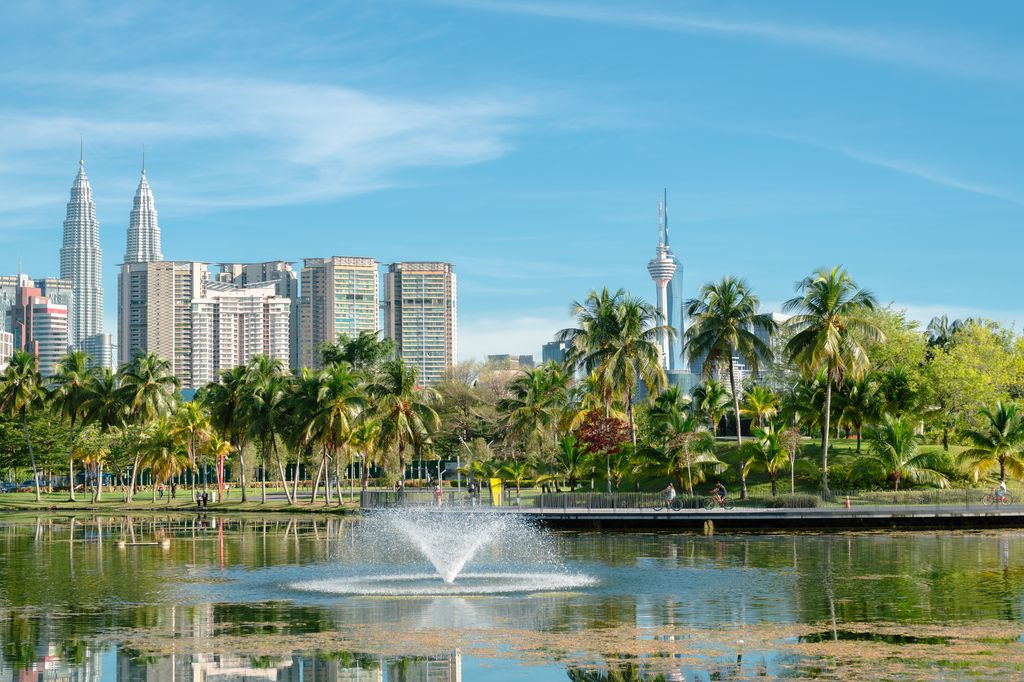 Kuala Lumpur
Kuala Lumpur
2. What Can Tourists Expect from a Trip to Malaysia?
Tourists visiting Malaysia can anticipate a harmonious blend of cultural experiences, scenic landscapes, and contemporary conveniences. English is widely spoken, making communication relatively easy for international travelers. The country is generally calmer, more organized, and more conservative compared to some of its Southeast Asian neighbors, offering a more relaxed travel environment.
Here’s a detailed look at what you can expect:
- Cultural Immersion: Experience the blend of Malay, Chinese, Indian, and indigenous cultures through festivals, food, and historical sites.
- Diverse Landscapes: Explore rainforests, beaches, highlands, and modern cityscapes.
- Friendly Locals: Known for their hospitality, Malaysians are generally welcoming and helpful to tourists.
- Modern Amenities: Enjoy reliable transportation, comfortable accommodations, and a range of modern facilities.
SIXT.VN can enhance your Malaysian adventure by providing seamless travel solutions, including airport transfers, hotel bookings, and curated tour packages that cater to your preferences, ensuring a memorable and stress-free experience.
3. How Does Malaysia’s Culture Impact the Tourist Experience?
Malaysia’s multicultural society significantly enriches the tourist experience by offering a wide range of cultural attractions and activities. The country’s cultural diversity is a major draw for tourists seeking unique experiences.
Key cultural aspects that enhance the tourist experience include:
- Religious Diversity: Mosques, temples, and churches coexist harmoniously, reflecting the country’s religious tolerance.
- Festivals: Numerous cultural and religious festivals are celebrated throughout the year, providing vibrant displays of tradition and heritage.
- Cuisine: The fusion of Malay, Chinese, and Indian culinary traditions results in a diverse and flavorful food scene.
- Arts and Crafts: Traditional arts and crafts, such as batik, weaving, and wood carving, are showcased in museums and local markets.
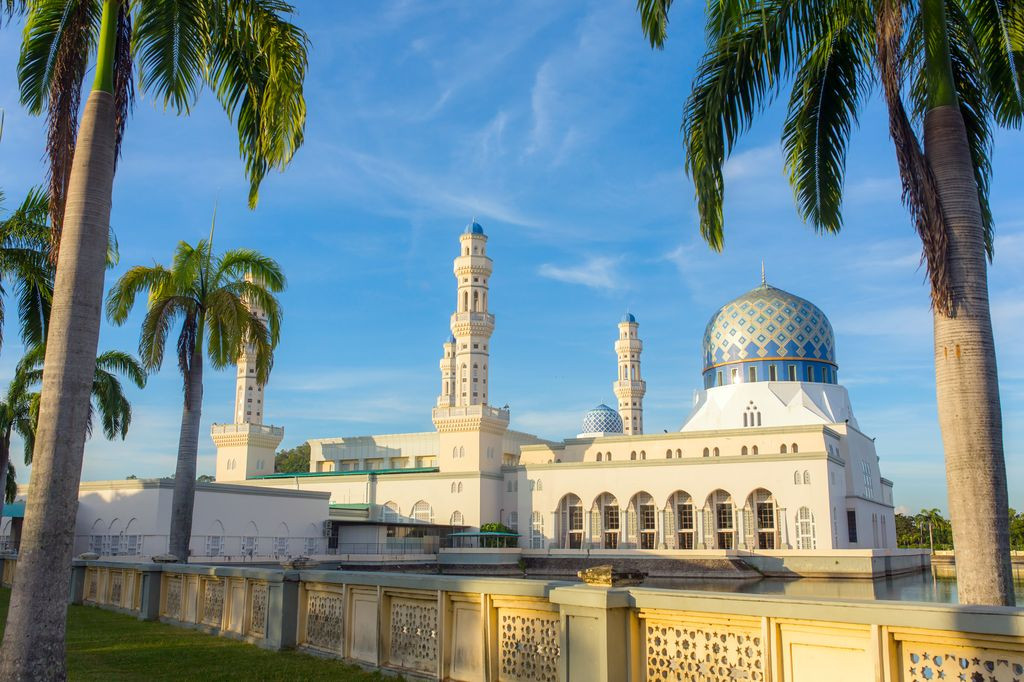 Mosque under a blue sky in Kota Kinabalu, Malaysia.
Mosque under a blue sky in Kota Kinabalu, Malaysia.
When exploring Malaysia, remember to respect local customs and traditions:
- Dress Modestly: When visiting religious sites, dress respectfully, covering shoulders and knees.
- Remove Shoes: Take off your shoes before entering temples and mosques.
- Use Right Hand: Use your right hand when eating or giving something to someone, as the left hand is considered unclean.
- Public Displays of Affection: Avoid excessive public displays of affection, as Malaysia is a conservative country.
- Alcohol Consumption: Be mindful of alcohol consumption, especially in public places and during religious events.
4. What Are Some Must-See Destinations in Malaysia for First-Time Visitors?
Malaysia is a treasure trove of attractions, offering something for every type of traveler. For first-time visitors, these destinations provide a perfect introduction to the country’s diverse offerings:
- Kuala Lumpur: The capital city is a modern metropolis with iconic landmarks like the Petronas Twin Towers and Batu Caves.
- Penang: Known for its street art, culinary scene, and historical architecture in Georgetown, a UNESCO World Heritage site.
- Langkawi: A tropical island with stunning beaches, duty-free shopping, and lush landscapes.
- Melaka: A historical city with a rich colonial past, offering a blend of Malay, Chinese, and European influences.
- Cameron Highlands: A cool mountain retreat with tea plantations, strawberry farms, and hiking trails.
- Borneo (Sabah & Sarawak): Explore the rainforests, caves, and wildlife of Malaysian Borneo, including Mount Kinabalu and the Kinabatangan River.
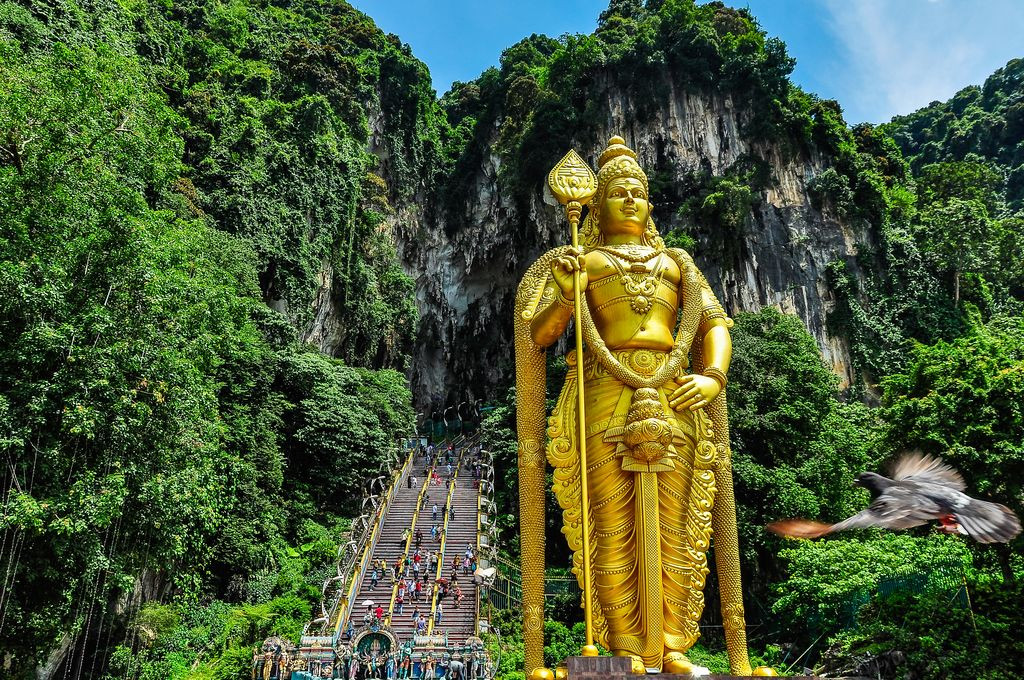 A giant golden statue of a Hindu god and the colorful stairs at the entrance of Batu Caves, Malaysia.
A giant golden statue of a Hindu god and the colorful stairs at the entrance of Batu Caves, Malaysia.
5. How Safe and Convenient Is It to Travel Around Malaysia?
Malaysia is generally considered a safe and convenient country for tourists, with a well-developed infrastructure and relatively low crime rates. The Global Peace Index consistently ranks Malaysia as one of the safest countries in Southeast Asia.
Here’s a breakdown of safety and convenience aspects:
- Safety: Violent crime is rare, but petty theft can occur, especially in crowded areas.
- Transportation: Malaysia has an excellent transportation network, including airports, highways, trains, and buses, making it easy to travel between cities and regions.
- Health: The country has a good healthcare system, with modern hospitals and medical facilities available in major cities.
- Communication: English is widely spoken, making it easy for tourists to communicate with locals.
For seamless transportation and peace of mind, SIXT.VN offers reliable airport transfer services, ensuring you reach your destination safely and comfortably. We also provide transportation options for exploring different parts of Malaysia, making your travel experience hassle-free.
6. What Are the Best Times of the Year to Visit Malaysia?
The best time to visit Malaysia depends on the region and your travel preferences. Generally, Malaysia has a tropical climate with high temperatures and humidity throughout the year.
Here’s a seasonal guide:
- West Coast (Kuala Lumpur, Penang, Langkawi): The dry season is from November to March, offering the best weather for outdoor activities and sightseeing.
- East Coast (Perhentian Islands, Tioman Island): The dry season is from March to September, ideal for beach holidays and water sports.
- Borneo (Sabah & Sarawak): The dry season is from March to September, perfect for exploring rainforests and wildlife.
SIXT.VN can help you plan your trip according to the best seasons, ensuring you get the most out of your Malaysian adventure. We offer customized itineraries that take into account the weather conditions and seasonal attractions, making your travel experience optimal.
7. What Types of Accommodation Are Available in Malaysia?
Malaysia offers a wide range of accommodation options to suit every budget and preference, from luxurious hotels to budget-friendly hostels and guesthouses.
Here are some popular types of accommodation:
- Luxury Hotels: Found in major cities and tourist destinations, offering top-notch amenities and services.
- Mid-Range Hotels: Provide comfortable rooms and good facilities at reasonable prices.
- Budget Hotels & Guesthouses: Offer basic but clean rooms for budget travelers.
- Hostels: Popular among backpackers, providing dormitory-style rooms and social environments.
- Resorts: Located in beach and island destinations, offering a range of leisure activities and facilities.
- Homestays: Provide an immersive cultural experience, allowing you to stay with local families.
SIXT.VN simplifies your accommodation booking process by offering a curated selection of hotels and resorts that cater to various budgets and preferences. We ensure you find the perfect place to stay, making your trip comfortable and enjoyable.
8. What Kind of Food Can Tourists Expect to Find in Malaysia?
Malaysian cuisine is a vibrant and diverse fusion of flavors, influenced by Malay, Chinese, Indian, and other Southeast Asian traditions. Food is a central part of Malaysian culture, and tourists can expect a culinary adventure filled with delicious and unique dishes.
Must-try Malaysian dishes include:
- Nasi Lemak: A fragrant rice dish cooked in coconut milk and pandan leaf, served with fried chicken, sambal, peanuts, and anchovies.
- Laksa: A spicy noodle soup with a rich coconut milk broth, prawns, chicken, and vegetables.
- Satay: Grilled skewers of marinated meat (chicken, beef, or lamb) served with peanut sauce, rice cakes, and cucumbers.
- Roti Canai: A flaky flatbread served with curry sauce, often eaten for breakfast.
- Char Kway Teow: Stir-fried rice noodles with prawns, cockles, Chinese sausage, and vegetables in a sweet and savory sauce.
 Food being prepared in the streets of Malaysia.
Food being prepared in the streets of Malaysia.
9. How Does Malaysia Compare to Other Southeast Asian Destinations?
Malaysia offers a unique travel experience that sets it apart from other Southeast Asian destinations like Thailand, Vietnam, and Indonesia. While each country has its own charm, Malaysia stands out for its blend of cultural influences, modern infrastructure, and diverse landscapes.
Here’s a comparison of Malaysia with other popular destinations:
- Thailand: Known for its beaches, nightlife, and budget-friendly prices, Thailand offers a more vibrant and bustling atmosphere compared to Malaysia’s more organized and conservative environment.
- Vietnam: Offers a rich history, stunning landscapes, and delicious street food, with a more adventurous and rustic travel experience compared to Malaysia’s modern amenities.
- Indonesia: The largest archipelago in the world, Indonesia boasts diverse cultures, stunning beaches, and natural wonders like Bali. Malaysia offers a more accessible and less overwhelming travel experience for first-time visitors.
- Singapore: A modern and cosmopolitan city-state, Singapore offers a high standard of living and world-class attractions. Malaysia provides a more diverse cultural and natural experience at a more affordable price.
10. What Are Some Tips for Planning a Budget-Friendly Trip to Malaysia?
Traveling to Malaysia can be budget-friendly with some careful planning and smart choices. Here are some tips for making the most of your money:
- Travel During the Off-Season: Enjoy lower prices on flights and accommodations by traveling during the shoulder seasons (April-May and September-October).
- Choose Budget Accommodation: Opt for guesthouses, hostels, or budget hotels for affordable lodging options.
- Eat Local Food: Savor delicious and affordable Malaysian cuisine at hawker centers and local restaurants.
- Use Public Transportation: Take advantage of Malaysia’s efficient and cheap public transportation system, including buses, trains, and metros.
- Free Activities: Explore free attractions like parks, temples, and street art in cities like Kuala Lumpur and Penang.
- Book in Advance: Secure better deals on flights, accommodations, and tours by booking in advance.
SIXT.VN offers budget-friendly travel solutions, including affordable airport transfers, economical hotel bookings, and cost-effective tour packages. We help you explore Malaysia without breaking the bank.
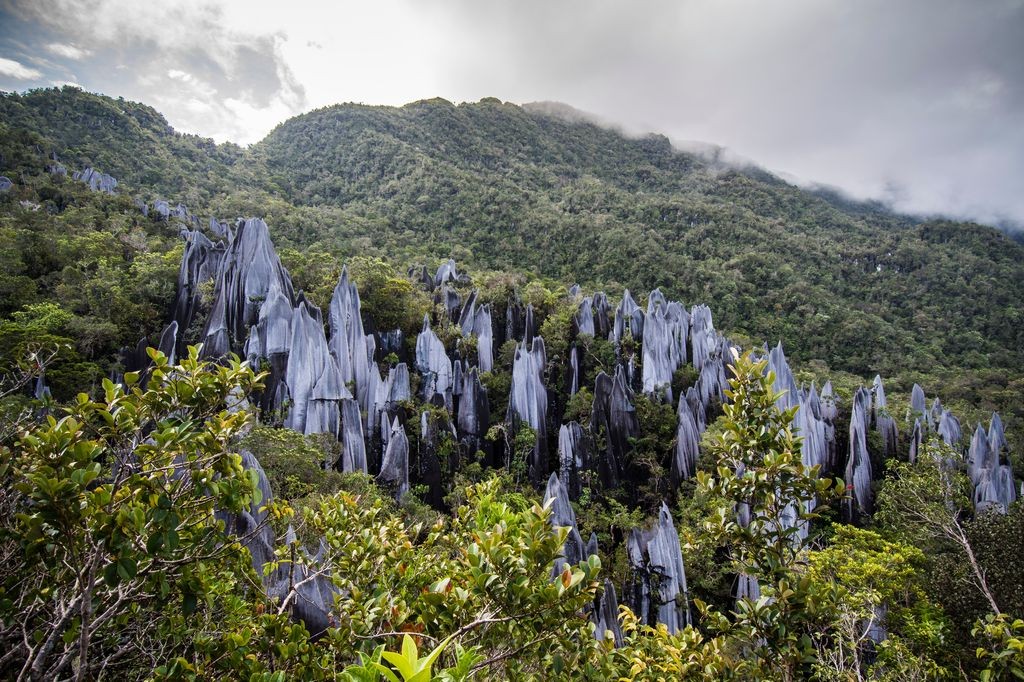 The pinnacle rocks of Gunung Mulu National Park, Malaysia.
The pinnacle rocks of Gunung Mulu National Park, Malaysia.
Malaysia’s unique blend of cultural diversity, natural beauty, and modern amenities makes it an excellent destination for travelers seeking a rich and fulfilling experience. Whether you’re exploring the vibrant cities, relaxing on pristine beaches, or venturing into lush rainforests, Malaysia offers something for everyone. With careful planning and the right resources, you can enjoy a memorable and affordable trip to this captivating country.
Ready to explore Malaysia? SIXT.VN is here to make your travel dreams a reality. Contact us today to start planning your personalized Malaysian adventure!
Address: 260 Cau Giay, Hanoi, Vietnam
Hotline/Whatsapp: +84 986 244 358
Website: SIXT.VN
FAQ: Is Malaysia Good For Tourism?
1. Is Malaysia a safe country for tourists?
Yes, Malaysia is generally a safe country for tourists. Violent crime is rare, but petty theft can occur, especially in crowded areas. It is advisable to take standard safety precautions such as keeping an eye on your belongings and avoiding walking alone in poorly lit areas at night. According to the Global Peace Index, Malaysia is one of the safest countries in Southeast Asia.
2. What is the best time to visit Malaysia?
The best time to visit Malaysia depends on the region you plan to visit. For the West Coast (Kuala Lumpur, Penang, Langkawi), the dry season from November to March offers the best weather. For the East Coast (Perhentian Islands, Tioman Island), the dry season from March to September is ideal. Borneo (Sabah & Sarawak) is best visited during the dry season from March to September.
3. Do I need a visa to travel to Malaysia?
Visa requirements for Malaysia vary depending on your nationality. Many nationalities, including those from the USA, EU, Australia, and Canada, can enter Malaysia without a visa for tourism purposes for up to 90 days. It is always best to check the latest visa requirements with the Malaysian embassy or consulate in your country before traveling.
4. Is English widely spoken in Malaysia?
Yes, English is widely spoken in Malaysia, especially in tourist areas, hotels, and major cities. About 60% of the population speaks English, making it easy for international tourists to communicate with locals.
5. What are some must-try foods in Malaysia?
Some must-try foods in Malaysia include Nasi Lemak (fragrant rice dish cooked in coconut milk), Laksa (spicy noodle soup), Satay (grilled meat skewers with peanut sauce), Roti Canai (flaky flatbread with curry), and Char Kway Teow (stir-fried rice noodles).
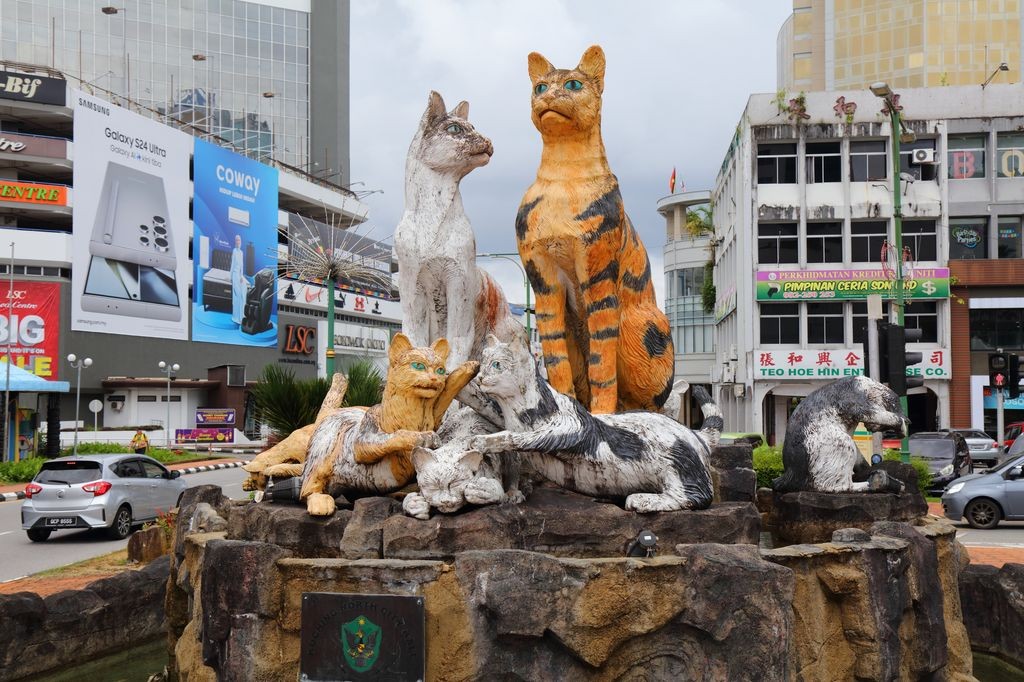 Statues of cats in Kuching, Malaysia.
Statues of cats in Kuching, Malaysia.
6. How easy is it to get around Malaysia?
It is very easy to get around Malaysia, thanks to its well-developed transportation network. Major cities have efficient public transportation systems, including buses, trains, and metros. Taxis and ride-hailing services are also readily available. For traveling between cities and regions, you can use domestic flights, trains, or long-distance buses.
7. What types of accommodation are available in Malaysia?
Malaysia offers a wide range of accommodation options to suit every budget, including luxury hotels, mid-range hotels, budget hotels, guesthouses, hostels, resorts, and homestays. You can find various options in major cities and tourist destinations.
8. Are credit cards widely accepted in Malaysia?
Credit cards are widely accepted in Malaysia, especially in major cities, hotels, and large establishments. However, it is a good idea to carry some cash with you, particularly when visiting smaller towns, local markets, or street food vendors.
9. What cultural customs should I be aware of in Malaysia?
When visiting Malaysia, it is important to respect local customs and traditions. Dress modestly when visiting religious sites, remove your shoes before entering temples and mosques, use your right hand when eating or giving something to someone, avoid excessive public displays of affection, and be mindful of alcohol consumption, especially in public places and during religious events.
10. What are some popular activities in Malaysia?
Popular activities in Malaysia include exploring the Petronas Twin Towers and Batu Caves in Kuala Lumpur, enjoying street art and culinary delights in Penang, relaxing on the beaches of Langkawi, visiting historical sites in Melaka, hiking in the Cameron Highlands, and exploring the rainforests and wildlife in Borneo (Sabah & Sarawak).



